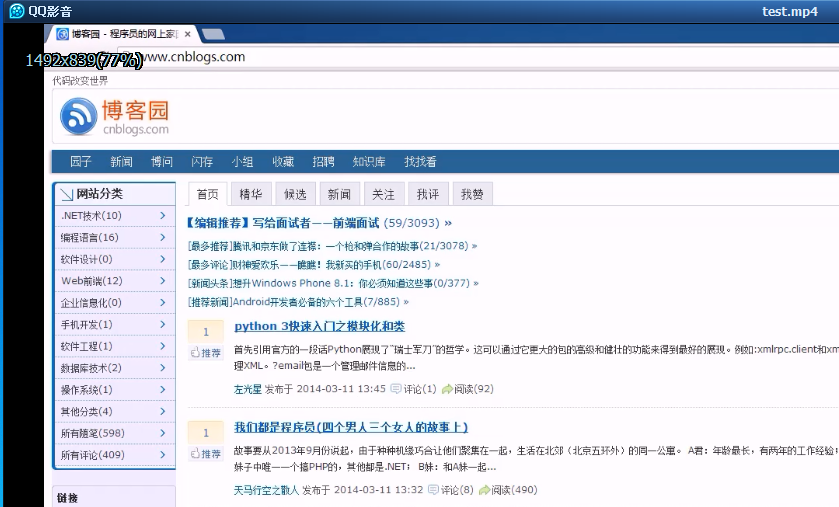C#实现录制屏幕
以前写过两篇录制麦克风语音和摄像头视频的文章(实现语音视频录制、在服务器端录制语音视频),最近有朋友问,如果要实现屏幕录制这样的功能,该怎么做了?实际上原理是差不多的,如果了解了我前面两篇文章中介绍的内容,只要在它们的基础上做一些修改就可以了。
一.实现原理
实现方案仍然基于OMCS+MFile构建,原理与实现语音视频录制差不多,我这里只列出其中的主要差异:
(1)使用DynamicDesktopConnector连接到屏幕桌面。
(2)使用定时器(比如10fps,则每隔100ms一次)定时调用DynamicDesktopConnector的GetCurrentImage方法,把得到的图像使用MFile写入视频文件。
(3)Demo演示的是不需要同时录制麦克风的声音,所以使用了MFile提供的SilenceVideoFileMaker组件(而非原来的VideoFileMaker组件),仅仅录制视频数据。
(4)通过MultimediaManager的DesktopEncodeQuality属性,控制屏幕图像的清晰度。
二.实现代码
该Demo的所有源码如下所示,如果不想下载Demo,可以直接通过下面的代码了解详细的实现思路。
public partial class Form1 : Form { private MultimediaServer server; //在本地内嵌OMCS服务器 private IMultimediaManager multimediaManager; private SilenceVideoFileMaker maker = new SilenceVideoFileMaker(); //录制无声视频 private DynamicDesktopConnector dynamicDesktopConnector = new DynamicDesktopConnector(); //远程桌面连接器 public Form1() { InitializeComponent(); int port = 9900; OMCSConfiguration config = new OMCSConfiguration(10,8, EncodingQuality.High,16000,640,480,"") ; this.server = new MultimediaServer(port, new DefaultUserVerifier(), config, false, null); this.multimediaManager = MultimediaManagerFactory.GetSingleton(); this.multimediaManager.DesktopEncodeQuality = 1; //通过此参数控制清晰度 this.multimediaManager.Initialize("aa01", "", "127.0.0.1", port); this.dynamicDesktopConnector.ConnectEnded += new ESBasic.CbGeneric<ConnectResult>(dynamicDesktopConnector_ConnectEnded); this.dynamicDesktopConnector.BeginConnect("aa01"); //连接本地桌面 this.Cursor = Cursors.WaitCursor; } void dynamicDesktopConnector_ConnectEnded(ConnectResult obj) { System.Threading.Thread.Sleep(500); this.Ready(); } private void Ready() { if (this.InvokeRequired) { this.BeginInvoke(new CbGeneric(this.Ready)); } else { this.Cursor = Cursors.Default; this.button1.Enabled = true; this.label1.Visible = false; } } private System.Threading.Timer timer; private void button1_Click(object sender, EventArgs e) { try { Oraycn.MFile.GlobalUtil.SetAuthorizedUser("FreeUser", ""); //初始化H264视频文件 this.maker.Initialize("test.mp4", VideoCodecType.H264, this.dynamicDesktopConnector.DesktopSize.Width, this.dynamicDesktopConnector.DesktopSize.Height, 10); this.timer = new System.Threading.Timer(new System.Threading.TimerCallback(this.Callback), null ,0, 100); this.label1.Text = "正在录制......"; this.label1.Visible = true; this.button1.Enabled = false; this.button2.Enabled = true; } catch (Exception ee) { MessageBox.Show(ee.Message); } } //定时获取屏幕图像,并使用MFile写入视频文件 private void Callback(object state) { Bitmap bm = this.dynamicDesktopConnector.GetCurrentImage(); this.maker.AddVideoFrame(bm); } private void button2_Click(object sender, EventArgs e) { this.timer.Dispose(); this.button1.Enabled = false; this.button2.Enabled = false; this.label1.Visible = false; this.maker.Close(true); MessageBox.Show("生成视频文件成功!"); } }
三.Demo下载
F5运行Demo,我录制了一段时间的自己桌面为mp4视频文件(我的屏幕分辨率为1920*1080),然后,使用QQ影音播放效果如下:

本文的Demo还可以做更多的扩展,比如:
(1)当前demo仅仅是录制了无声的屏幕图像,如果希望在录制屏幕的同时,录制麦克风的声音(比如,录制课件时经常有这样的需求),那么,可以引入MicrophoneConnector,并使用MFile的VideoFileMaker组件就可以了。
(2)如果把OMCS服务端从demo中拆出来,并用两个客户端帐号登录,就可以实现远程屏幕录制了。当然,这需要有足够大的带宽来支持。
